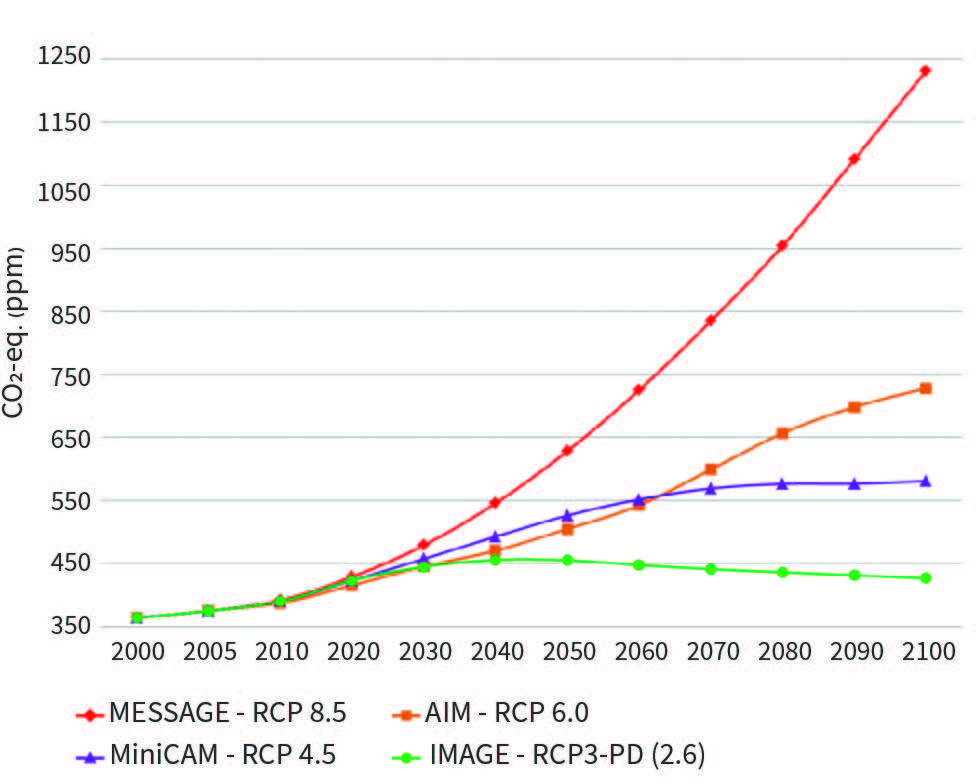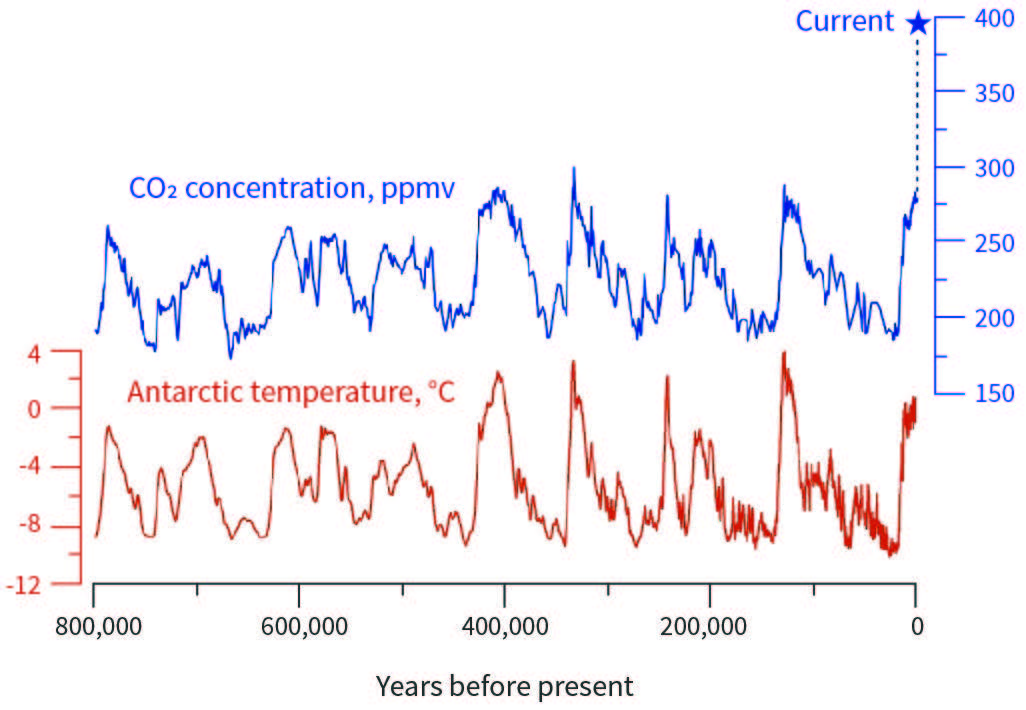6.5: Climate Prediction
- Page ID
- 11173
\( \newcommand{\vecs}[1]{\overset { \scriptstyle \rightharpoonup} {\mathbf{#1}} } \)
\( \newcommand{\vecd}[1]{\overset{-\!-\!\rightharpoonup}{\vphantom{a}\smash {#1}}} \)
\( \newcommand{\id}{\mathrm{id}}\) \( \newcommand{\Span}{\mathrm{span}}\)
( \newcommand{\kernel}{\mathrm{null}\,}\) \( \newcommand{\range}{\mathrm{range}\,}\)
\( \newcommand{\RealPart}{\mathrm{Re}}\) \( \newcommand{\ImaginaryPart}{\mathrm{Im}}\)
\( \newcommand{\Argument}{\mathrm{Arg}}\) \( \newcommand{\norm}[1]{\| #1 \|}\)
\( \newcommand{\inner}[2]{\langle #1, #2 \rangle}\)
\( \newcommand{\Span}{\mathrm{span}}\)
\( \newcommand{\id}{\mathrm{id}}\)
\( \newcommand{\Span}{\mathrm{span}}\)
\( \newcommand{\kernel}{\mathrm{null}\,}\)
\( \newcommand{\range}{\mathrm{range}\,}\)
\( \newcommand{\RealPart}{\mathrm{Re}}\)
\( \newcommand{\ImaginaryPart}{\mathrm{Im}}\)
\( \newcommand{\Argument}{\mathrm{Arg}}\)
\( \newcommand{\norm}[1]{\| #1 \|}\)
\( \newcommand{\inner}[2]{\langle #1, #2 \rangle}\)
\( \newcommand{\Span}{\mathrm{span}}\) \( \newcommand{\AA}{\unicode[.8,0]{x212B}}\)
\( \newcommand{\vectorA}[1]{\vec{#1}} % arrow\)
\( \newcommand{\vectorAt}[1]{\vec{\text{#1}}} % arrow\)
\( \newcommand{\vectorB}[1]{\overset { \scriptstyle \rightharpoonup} {\mathbf{#1}} } \)
\( \newcommand{\vectorC}[1]{\textbf{#1}} \)
\( \newcommand{\vectorD}[1]{\overrightarrow{#1}} \)
\( \newcommand{\vectorDt}[1]{\overrightarrow{\text{#1}}} \)
\( \newcommand{\vectE}[1]{\overset{-\!-\!\rightharpoonup}{\vphantom{a}\smash{\mathbf {#1}}}} \)
\( \newcommand{\vecs}[1]{\overset { \scriptstyle \rightharpoonup} {\mathbf{#1}} } \)
\( \newcommand{\vecd}[1]{\overset{-\!-\!\rightharpoonup}{\vphantom{a}\smash {#1}}} \)
\(\newcommand{\avec}{\mathbf a}\) \(\newcommand{\bvec}{\mathbf b}\) \(\newcommand{\cvec}{\mathbf c}\) \(\newcommand{\dvec}{\mathbf d}\) \(\newcommand{\dtil}{\widetilde{\mathbf d}}\) \(\newcommand{\evec}{\mathbf e}\) \(\newcommand{\fvec}{\mathbf f}\) \(\newcommand{\nvec}{\mathbf n}\) \(\newcommand{\pvec}{\mathbf p}\) \(\newcommand{\qvec}{\mathbf q}\) \(\newcommand{\svec}{\mathbf s}\) \(\newcommand{\tvec}{\mathbf t}\) \(\newcommand{\uvec}{\mathbf u}\) \(\newcommand{\vvec}{\mathbf v}\) \(\newcommand{\wvec}{\mathbf w}\) \(\newcommand{\xvec}{\mathbf x}\) \(\newcommand{\yvec}{\mathbf y}\) \(\newcommand{\zvec}{\mathbf z}\) \(\newcommand{\rvec}{\mathbf r}\) \(\newcommand{\mvec}{\mathbf m}\) \(\newcommand{\zerovec}{\mathbf 0}\) \(\newcommand{\onevec}{\mathbf 1}\) \(\newcommand{\real}{\mathbb R}\) \(\newcommand{\twovec}[2]{\left[\begin{array}{r}#1 \\ #2 \end{array}\right]}\) \(\newcommand{\ctwovec}[2]{\left[\begin{array}{c}#1 \\ #2 \end{array}\right]}\) \(\newcommand{\threevec}[3]{\left[\begin{array}{r}#1 \\ #2 \\ #3 \end{array}\right]}\) \(\newcommand{\cthreevec}[3]{\left[\begin{array}{c}#1 \\ #2 \\ #3 \end{array}\right]}\) \(\newcommand{\fourvec}[4]{\left[\begin{array}{r}#1 \\ #2 \\ #3 \\ #4 \end{array}\right]}\) \(\newcommand{\cfourvec}[4]{\left[\begin{array}{c}#1 \\ #2 \\ #3 \\ #4 \end{array}\right]}\) \(\newcommand{\fivevec}[5]{\left[\begin{array}{r}#1 \\ #2 \\ #3 \\ #4 \\ #5 \\ \end{array}\right]}\) \(\newcommand{\cfivevec}[5]{\left[\begin{array}{c}#1 \\ #2 \\ #3 \\ #4 \\ #5 \\ \end{array}\right]}\) \(\newcommand{\mattwo}[4]{\left[\begin{array}{rr}#1 \amp #2 \\ #3 \amp #4 \\ \end{array}\right]}\) \(\newcommand{\laspan}[1]{\text{Span}\{#1\}}\) \(\newcommand{\bcal}{\cal B}\) \(\newcommand{\ccal}{\cal C}\) \(\newcommand{\scal}{\cal S}\) \(\newcommand{\wcal}{\cal W}\) \(\newcommand{\ecal}{\cal E}\) \(\newcommand{\coords}[2]{\left\{#1\right\}_{#2}}\) \(\newcommand{\gray}[1]{\color{gray}{#1}}\) \(\newcommand{\lgray}[1]{\color{lightgray}{#1}}\) \(\newcommand{\rank}{\operatorname{rank}}\) \(\newcommand{\row}{\text{Row}}\) \(\newcommand{\col}{\text{Col}}\) \(\renewcommand{\row}{\text{Row}}\) \(\newcommand{\nul}{\text{Nul}}\) \(\newcommand{\var}{\text{Var}}\) \(\newcommand{\corr}{\text{corr}}\) \(\newcommand{\len}[1]{\left|#1\right|}\) \(\newcommand{\bbar}{\overline{\bvec}}\) \(\newcommand{\bhat}{\widehat{\bvec}}\) \(\newcommand{\bperp}{\bvec^\perp}\) \(\newcommand{\xhat}{\widehat{\xvec}}\) \(\newcommand{\vhat}{\widehat{\vvec}}\) \(\newcommand{\uhat}{\widehat{\uvec}}\) \(\newcommand{\what}{\widehat{\wvec}}\) \(\newcommand{\Sighat}{\widehat{\Sigma}}\) \(\newcommand{\lt}{<}\) \(\newcommand{\gt}{>}\) \(\newcommand{\amp}{&}\) \(\definecolor{fillinmathshade}{gray}{0.9}\)So, as the Danish physicist Niels Bohr once remarked, “Prediction is very difficult, especially about the future.” There are roughly 40 climate models run by different organizations around the world, and they all give somewhat different predictions about the response of climate to increasing concentrations of greenhouse gases. In addition, we have to estimate just how the greenhouse gas content of the atmosphere will evolve over the coming centuries, which requires not just an understanding of the physics, chemistry, and biology controlling these gases but an assessment of human behavior— how much greenhouse gas will we end up emitting?
This is a problem of economic and behavioral forecasting, including, very importantly, predicting population growth. Will developed nations learn how to better conserve energy? Will the economies of countries like India expand rapidly, as China’s did, leading to rapid growth in energy demand? How far will low-carbon energy technologies penetrate the energy sector? There are strong interdependencies among these issues. For example, recent experience shows that as gross national product per capita expands together with per capita energy consumption, population growth tends to level off, ameliorating the growth in energy demand. All these factors strongly affect greenhouse gas emissions.
To deal with all this, the Intergovernmental Panel on Climate Change (IPCC)* came up with a set of just four “representative concentration pathways” (RCPs), expressing plausible evolutions of greenhouse gases and other anthropogenic influences on climate, such as aerosols. These are labeled with the associated net radiative forcing in the year 2100; so, for example, RCP 6.0 has a radiative forcing of 6 watts per square meter by the year 2100. (For comparison, doubling CO2 produces a radiative forcing of about 4 watts per meter squared.) Figure 8 shows the evolutions of these concentration pathways, expressed as though all the forcing is due to CO2 alone. (That is, we take the radiative forcings associated with other greenhouse gases like methane and nitrous oxide, and with aerosols, and convert them into CO2- equivalent units.)
IPCC Hypothetical CO2 Concentration Pathways

The red curve in Figure \(\PageIndex{1}\), RCP 8.5, is a pessimistic projection that assumes no serious effort to curtail greenhouse gas emissions, and robust economic growth. By the end of the century, the CO2 equivalent has quadrupled from preindustrial levels, to around 1230 ppm. To get a feel for how extraordinary such a value is, try plotting it on Figure \(\PageIndex{2}\) which we have seen before .
Temperature and CO2 From Antarctic Ice Cores Over the Past 800,00 Years

Paleoclimate proxies suggest that such a value has not been seen since at least the Eocene period, roughly 50 million years ago, when alligators roamed Greenland, and sea level was 70 meters (about 230 feet) higher than today’s. If the climate were to equilibrate to the associated radiative forcing of 8.5 watts per meter squared, extrapolation of the IPCC temperature projections would yield a global warming of 3–9 K (about 5–16 °F).
The other three RCPs assume some level of mitigation of greenhouse gas emissions and are useful for estimating how various mitigation strategies might ameliorate climate change.
Global Temperature Projections
.pdf_-_Adobe_Acrobat_Pro_DC.jpg?revision=3)
The projected response of global mean surface temperature depends on both the emissions trajectory and the climate model used to make the projection. In its Fifth Assessment Report, the IPCC summarizes this response, shown in Figure \(\PageIndex{3}\), which extends to the year 2300. The color shading for each curve in the figure represents the scatter among the various climate models used to make the projections. Note that if nothing is done to curb emissions, and economic growth proceeds rapidly in the developing world, global mean temperature may rise by between 2.5 and 4.5 °C (4.5 to 8 °F) by 2100, and between 4 and 13 °C (7 and 23 °F) by 2300. But what are the consequences of these changes? How will they affect us in human and economic terms? We next consider the set of real risks that climate change poses and how, at least for some risks, we might go about attaching actual numbers to the risks.
The IPCC does not perform research, but it coordinates research efforts and periodically summarizes climate research and predictions for the
benefit of the public. Researchers from around the world send in their results in standardized formats so they can easily be compared. The series
of IPCC reports constitutes singularly the most extensive coherent effort by a scientific discipline to convey research results to the public.

